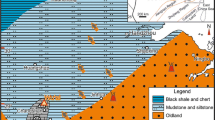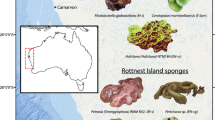Summary
Two patch reefs which predominately consist of the oysterNanogyra nana (Sowerby 1822) are exposed in Lower Kimmeridigian strata of the Langenberg hillrange, central Germany. Left oyster valves making up the frame-work of the reefs formed small abundant cavities that were inhabited by a unique sponge community. The excellent preservation of non-rigid sponges was related to early organomineralization within the decaying sponge tissue. As a process of sponge taphonomy, different types of microbially induced carbonates precipitated preserving spicule aggregates. Organomineralization within sponge soft tissues is especially favored with the Langenberg patch reefs due to the closed or semi-closed system conditions with the cavities. The δ13C values ofin situ formed microbialities reveal that carbonate precipitation was in equilibrium with Jurassic seawater. The carbon of the microbialites does not derive from the bacterial remineralization of organic matter, but is of a marine source. Likewise, organomineralization is probably related to bacterial EPS or decaying sponge tissues providing an organic matrix for initial carbonate precipitation.
Biomarker analyses revealed, that the patch reef microbialites contain terminally branched fatty acids (iso-andanteiso-pentadecanoic acid) in significant concentrations. These fatty acids, like hopanoid hydrocarbons, are most likely of a bacterial source. This is in agreement with sulfate-reducing bacteria remineralizing the decaying sponges as further indicated by the occurrence of framboidal pyrite in sponge microbialites.
Similar content being viewed by others
References
Arp, G., Thiel, V., Reimer, A., Michaelis, W. and Reitner, J. (1999): Biofilm exopolymers control microbialite formation at thermal springs discharging into the alkaline Pyramid Lake, Nevada, USA.—Sediment. Geol.,126, 159–176, Amsterdam
Bergquist, P.R. (1978): Sponges.—268p. Berkeley, Los Angeles (University of California Press)
Bonci, M.C., Magnino, G., Pirini Radrizzani, C., and Pronzato R. (1997): Finding ofGeodia (Demospongiae) sterrasters in the Late Miocene of Capella Montei (Alessandria) and comparison with living forms.—Boll. Soc. Paleont. Italiana,35/3, 245–256, Modena
Boon, J.J., de Leeuw, J.W., Hoeck, V.G. and Vosjan J.H. (1977): The significance of taxonomical value ofiso- andanteiso-monoenic fatty acids and branched β-hydroxy acids inDesulfovibrio desulfuricans.—J. Bacteriol.,129, 1183–1191
Bourque, P.-A. and Gignac, H. (1983): Sponge-constructed stromatactis mud mounds, Silurian of Gaspé, Québec.—J. Sediment. Petrol.,53/2, 0521–0532, Tulsa
Coleman, M.L. (1993): Microbial processes: Controls on the shape and composition of carbonate concretions.—Marine Geol.,113, 127–140, Amsterdam
Cooper, W.J. and Blumer M. (1968): Linear,iso andanteiso fatty acids in Recent sediments of the North Atlantic.—Deep-Sea Res.,15, 535–540
Díaz, M.C., Soest, v.R.W.M. and Pomponi, S.A. (1991): A Systematic Revision of the Central-Atlantic Halichondrida (Demospongiae, Porifera). Part I: Evaluation of Characters and Diagnosis of Genera.—In: Reitner, J. and Keupp, H. (eds., 1991): Fossil and Recent Sponges, 134–149, Berlin (Springer)
Dowling, N.J.E., Widdel, F. and White, D.C. (1986): Phospholipid ester-linked fatty acid biomarkers of acetate-oxidizing sulfate reducers and other sulfide-forming bacteria. J. Gen. Microbiol.,132, 1815–1825
Farrimond, P., Head, I.M. and Innes, H.E. (2000): Environmental influence on the biohopanoid composition of Recent sediments. —Geochim. Cosmochim. Acta,64, 2985–2992; Amsterdam
Fischer, R. (1991): Die Oberjura-Schichtfolge vom Langenberg bei Oker.—Arbeitskreis Paläont. Hannover,19/2, 21–36, Hannover
Flajs, G. and Hüssner, H. (1993): A microbial model for the Lower Devonian stromatactis mud mounds of the Montagne Noir (France).—Facies,29, 179–194, Erlangen
Fürsich, F.T. and Werner W. (1986): Benthic associations and their environmental significance in the Lusitanian Basin (Upper Jurassic, Portugal).—N. Jb. Geol. Paläont. Abh.,172, 271–329, Stuttgart
Gramann, F., Heunisch, C., Klassen, H., Kockel, F., Dulce, G., Harms, F.-J., Katschorek, T., Mönning, E., Schudack, M., Schudack, U., Thies, D. and Weiss, M., Koordination: Hinze, C. (1997): Das Niedersächsische Oberjura-Becken-Ergebnisse interdisziplinärer Zusammenarbeit.—Z. dt. geol. Ges.,148/2, 165–236, Stuttgart
Gruber, G. and Reitner, J. (1991): Isolierte Mikro-und megaskleren von Porifera aus dem Untercampan von Höver (Norddeutsch-la d) und Bemerkungen zur Phylogenie der Geodiidae (Demospongiae).—Berliner Geowiss. Abh., A,134, 107–117, Berlin
Hallam, A. (1976): Stratigraphic distribution and ecology of European Jurassic bivalves.—Lethia,9, 245–259, Olso
Haslett, S.K. (1992): Rhaxellid sponge microscleres from the Portlandian of Dorset, UK.—Geol. J.,27, 339–347, Liverpool
Hinde, G.J. (1890): On a genus of siliceous sponges from the lower calcareous grit of Yorkshire.—Quart. J. geol. Soc. London,46, 54–61, London
Kaneda, T. (1991):Iso-andanteiso-fatty acids in bacteria: biosynthesis, function, and taxonomic significance.—Microbiol. Rev.,55, 288–302
Kastner, A. (1988): Makrobenthosvergesellschaftungen aus dem Unteren und Mittleren Kimmeridge vom Langenberg bei Oker. —Diplomarb. Univ. Hannover, 124 p., Hannover (unpubl.)
Kennard, J.M. and James, N.P. (1986): Thrombolites and stromatolites: Two distinct types of microbial structures.—Palois,1/5, 492–503, Tulsa
Keupp, H., Jenisch, A., Herrmann, R., Neuweiler, F. and Reitner, J. (1993): Microbial Carbonate Crusts—a Key to the Environmental Analysis of Fossil Spongiolites?—Facies,29, 41–54, Erlangen
Leinfelder, R.R., Nose, M., Schmid, D.U. and Werner, W. (1993): Microbial crusts of the Late Jurassic: Composition, palaeoecological significance and importance in reef construction.—Facies,29, 195–230, Erlangen
Leo, R.G. and Parker, P.L. (1966): Branched chain fatty acids in sediments.—Science,152, 649–650
Lowenstam and Weiner (1989): On Biomineralisation.—324 p., Oxford (Oxford Univ. Press)
McCrea, C.M. (1950): The isotopic chemistry of carbonates and a paleotemperature scale.—J. Chem. Phys.,18, 849–857, Lancaster
Mostler, H. (1986): Neue Kieselschwämme aus den Zlambachschichten (Obertrias, Nördliche Kalkalpen).—Geol. Paläont. Mitt. Innsbruck,13, 331–361, Innsbruck
Mudroch, A. and Thies, D. (1996): Knochenfischzähne (Osteichtyes, Actinopterygii) aus dem Oberjura (Kimmeridgium) des Langenbergs bei Oker (Norddeutschland).—Geol. et Palaeont.,30, 239–265, Marburg
Ourisson, G., Albrecht, P. and Rohmer, M. (1979): The hopanoids. Paleochemistry and biochemistry of a group of a group of natural products.—Pure and Appl. Chem.,51, 709–729
Pape, H.G. (1970): Die Malmschichtfolge vom Langenberg bei Oker (nördl. Harzvorland).—Mit. Geol. Inst. TU Hannover9, 41–134, Hannover
Peckmann, J., Paul, J. and Thiel, V. (1999): Bacterially mediated formation of diagenetic aragonite and native sulfur in Zechstein carbonates (Upper Permian, Central Germany).—Sediment. Geol.,126, 205–222, Amsterdam
Perry, G.J., Volkman, J.K., Johns, R.B. and Bavor, H.J. Jr (1979): Fatty acids of bacterial origin in contemporary marine sediments.—Geochim. Cosmochim. Acta,43, 1715–1725, Amsterdam
Pisera, A. (1997): upper Jurassic siliceous sponses from the Swabian Alb: Taxonomy and Paleoecology.—Palaont. Polonica57, 216 p. Warszawa
Reinhold, C. (1996): Prozesses, Steuerung und Produkte komplexer Diagenese-Sequenzen in süddeutschen Malm-Karbonaten.—Diss. Technische Univ. Berlin, 255 p., Berlin
Reitner, J. (1987): Phylogenie und Konvergenzen bei rezenten und fossilen Calcarea (Porifera) mit einem kalkigen Basalskelett (“Inozoa, Pharetronida”).—Berliner geowiss. Abh., A,86, 87–125, Berlin
Reintner, J. (1992): “Coralline Spongien”. Der Versuch einer phylogenetisch-taxonomischen Analyse.—Berliner geowiss. Abh., E,1, 352 p., Berlin
Reitner, J. (1993): Modern Cryptic Microbialite/Metazoan Facies from lizard island (Great Barrier Reef, Australia) Formation and Concepts.—Facies,29, 3–40, Erlangen.
Reitner, J. (1994): Mikrobialith-Porifera Fazies eines Exogyren/Korallen Patchreefs des oberen Korallenooliths in Steinbruch Langenberg bei Oker (Niedersachsen).—Berliner geowiss. Abh. (E),13, 397–417, Berlin
Reitner, J., Gautret, P., Marin, F., Neuweiler, F. and Cuif, J.P. (1995): Automicrites in a modern microbialite—Formation model via organic matrices (Lizard Island, Great Barrier Reef, Australia).—Bull. Inst. oceanogr. Monaco, num spec.,14/2, 237–263, Monaco
Reitner, J. and Keupp, H. (1989): Basalskelette bei Schwämmen, Beispiel einer polyphyletischen Entwicklung.—Die Geowissenschaften, 7 Jahrg.,1989/3, 71–78, Weinheim
Reitner, J. and Keupp, H. (1991): The Fossil Record of the Haplosclerid Excavating SpongeAka de Laubenfels.—In: Reitner, J. and Keupp, H. (eds.): Fossil and Recent Sponges, 102–120, Berlin (Springer)
Reitner, J., Neuweiler, F. and Gautret, P. (1995): Modern and fossil automicrites: Implications for mud mound genesis.—In: Reitner, J. and Neuweiler, F. (coord.): Mud Mounds: A Polygenetic Spectrum of Fine-grained Carbonate Buildups, Part II.—Facies,32, 4–17, Erlangen
Reitner, J and Schumann-Kindel, G. (1997): Pyrite in mineralized sponge tissue—Product of sulfate reducing sponge related bacteria?—In: Neuweiler, F. and Reitner, J. and, Monty, CI. (eds.): Biosedimentology of Microbial Buildups.—IGCP Project No. 380, Proceedings of 2nd Meeting, Göttingen/Germany 1996, Facies,36, 272–276, Erlangen
Reitner, J., Thiel, V., Zankl, H., Michaelis, W., Wörheide, G. and Gautret, P. (2000): Organic and Biogeochemical Patterns in Cryptic Microbialites.—In: Riding, R.E. and Awramik, S.M. (Eds.), Microbial Sediments, 149–160; Springer (Berlin)
Reitner, J., Wörheide, G., Lange, R. and Schumann-Kindel, G. (2001): Coralline demosponges—a geobiological portrait.—Bull. Tohoku Univ Museum, 1, 210–226
Rich, C. (1958): Occurence of Sterrasters of the Geodiidae (Demospongea, Choristida) in Late Cenozoic strata of Western Wellington Province, New Zealand.—N. Z. J. Geol. Geophys.,1, 641–646, Wellington
Rigby, J.K. and Smith, C.C. (1992): Microscleres of a PaleoceneGeodia from Western Alabama.—J. Paleont.,66/3, 406–413, Tulsa
Rohmer, M., Bouvier-Nave, P. and Ourisson, G. (1984): Distribution of hopanoid triterpenes in procaryotes.—J. Gen. Microbiol.,1, 255–271
Schmid, D.U. (1996): Marine Mikrobolithe und Mikroinkrustierer aus dem Oberjura.—Profil,9, 101–251, Stuttgart
Soest, v.R.W.M., Díaz, M.C. and Pomponi, S.A. (1990): Phylogenetic classification of the Halichondrids (Porifera, Demospongiae).—Beaufortia,40/2, 15–62, Amsterdam
Stenzel, H.B. (1971): Oysters: N 953-1224.—In: Moore, R.C. (1971): Treatise on Invertebrate Paleontology.—Part N, Volume3, (3 of 3), Mollusca 6, Bivalvia, Lawrence, Kansas (W. Univ. Kansas Press)
Thiel, V., Peckmann, J., Richnow, H.H., Luth, U., Reitner, J. and Meichaelis, W. (2001) Molecular signals for anaerobic methane oxidation in Black Sea seep carbonates and a microbial mat.—Mar. Chem.,73, 97–112
Townson, W.G. (1975): Lithostratigraphy and deposition of the type Portlandian.—J. Geol. Soc London,131, 619–638, London
Trejo, M. (1967): La esponja fosilRhaxella sorbyana (Blake) y su significacion estratigrafica.—Bol. Asoc. Mex. Geol. Petrol.,19/1–6, 33–38, Mexico
Uriz, M.J. (1982): Estudio sistematico de las eponjas Astrophorida (Demospongia) de los fondos de pesca de arrastre entre Tossa y Calella (Cataluña).—Boll. Inst. Espa. Oceano.,6, 8–58
Vacelet, J. (1991): Recent Calcarea with a Reinforced Skeleton (‘Pharetronid’).—In: Reitner, J. and Keupp, H. (eds., 1991): Fossil and Recent Sponges.—S. 252–265, Berlin
Veizer, J., Ala, D., Azmy, K., Bruckschen, P., Buhl, D., Bruhn, F., Carden, G.A.F., Diener, A., Ebneth, S., Godderis, Y., Jasper, T., Korte, C., Pawellek, F., Podlaha, O.G. and Strauss, H. (1999):87Sr/86Sr, δ13C and δ18C evolution of Phanerozoic 3 seawater.—Chem. Geol.,161, 59–88
Wakeham, S.G. and Beier, J.A. (1991): Fatty acid and sterol biomarkers as indicators of particulate organic matter source and alteration processes in the Black Sea.—Deep-Sea Res.,38, (Suppl. 2), 943–968
Weiner, S., Traub, W. and Lowenstam, H.A. (1983): Organic matrix in calcified exoskeletons.—In: Westbroek, P. and Jong, E.W. de (eds.): Biomineralization and Biological Metal Accumulation.—205–224, Amsterdam.
Weiss, M. (1997): Die biostratigraphische Einstufung der Grenze Korallenoolith/Kimmeridge in NW-Deutschland—Kenntnisstand und neue Ergebnisse.—Z. geol. Wiss.,25/1/2, 109–120, Berlin
Wiedenmayer, F. (1994): Contributions to the knowledge of post-Palaeozoic neritic and archibenthal sponges (Porifera).—Schweizerische Paläont. Abh.,116 147 p., Basel
Wirsing, G. (1988): Mikrofazielle und diagenetische Entwicklung einer oberjurassischen Karbonatabfolge (Weißjura beta bis delta 4, Mittlere Schwäbische Alb) mit Berücksichtigung der chemischen Diagenese ausgewählter karbonatischer Bestandteile.—Heidelberger Geowiss. Abh.,15, 337 p., Heidelberg
Ziegler, P.A. (1982): Geological Atlas of Western and Central Europe.—130 p. Amsterdam (Shell Internationale Petroleum Maatschappij B.V.)
Author information
Authors and Affiliations
Rights and permissions
About this article
Cite this article
Delecat, S., Peckmann, J. & Reitner, J. Non-rigid cryptic sponges in oyster patch reefs (Lower Kimmeridgian, Langenberg/Oker, Germany). Facies 45, 231–254 (2001). https://doi.org/10.1007/BF02668115
Received:
Revised:
Issue Date:
DOI: https://doi.org/10.1007/BF02668115




